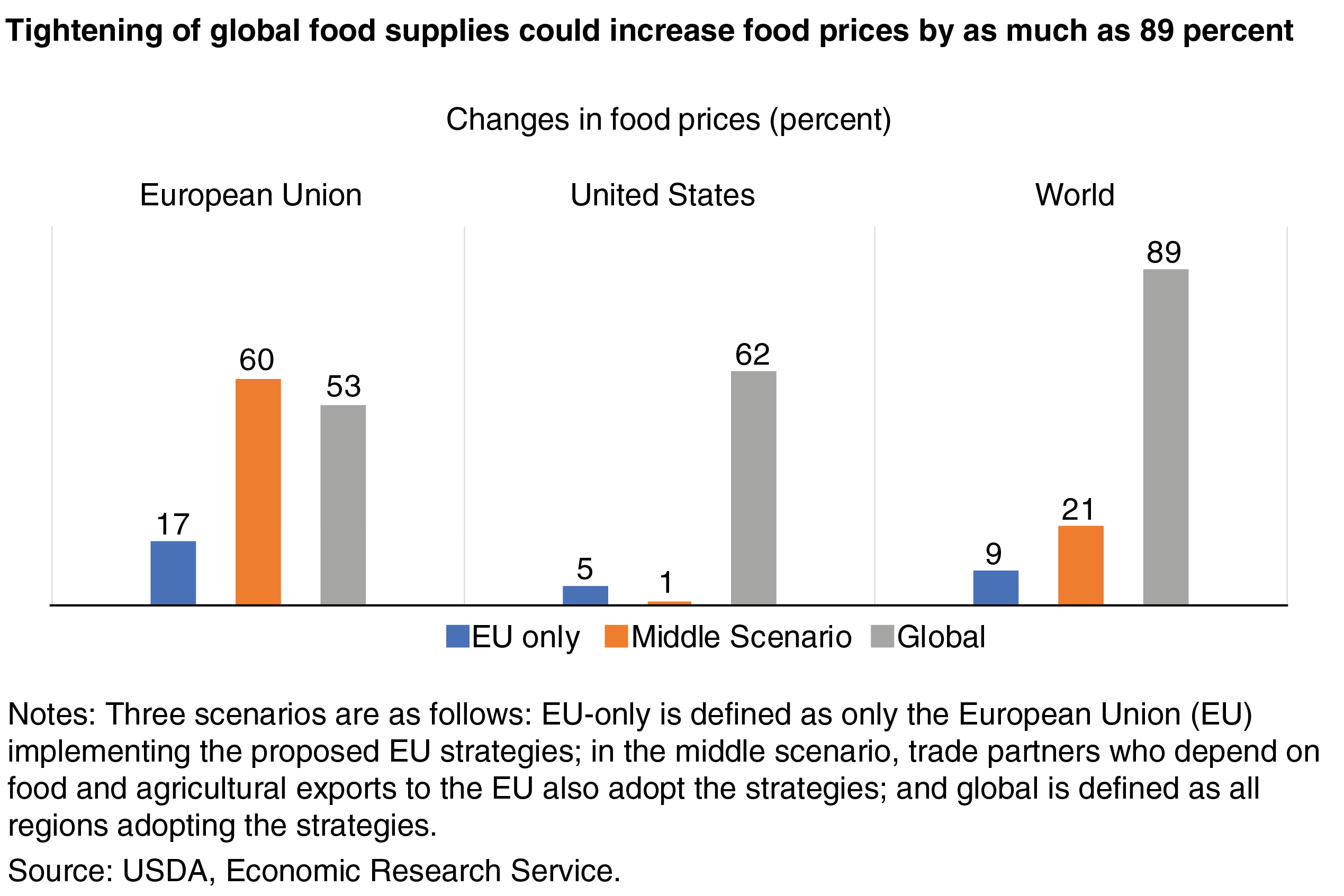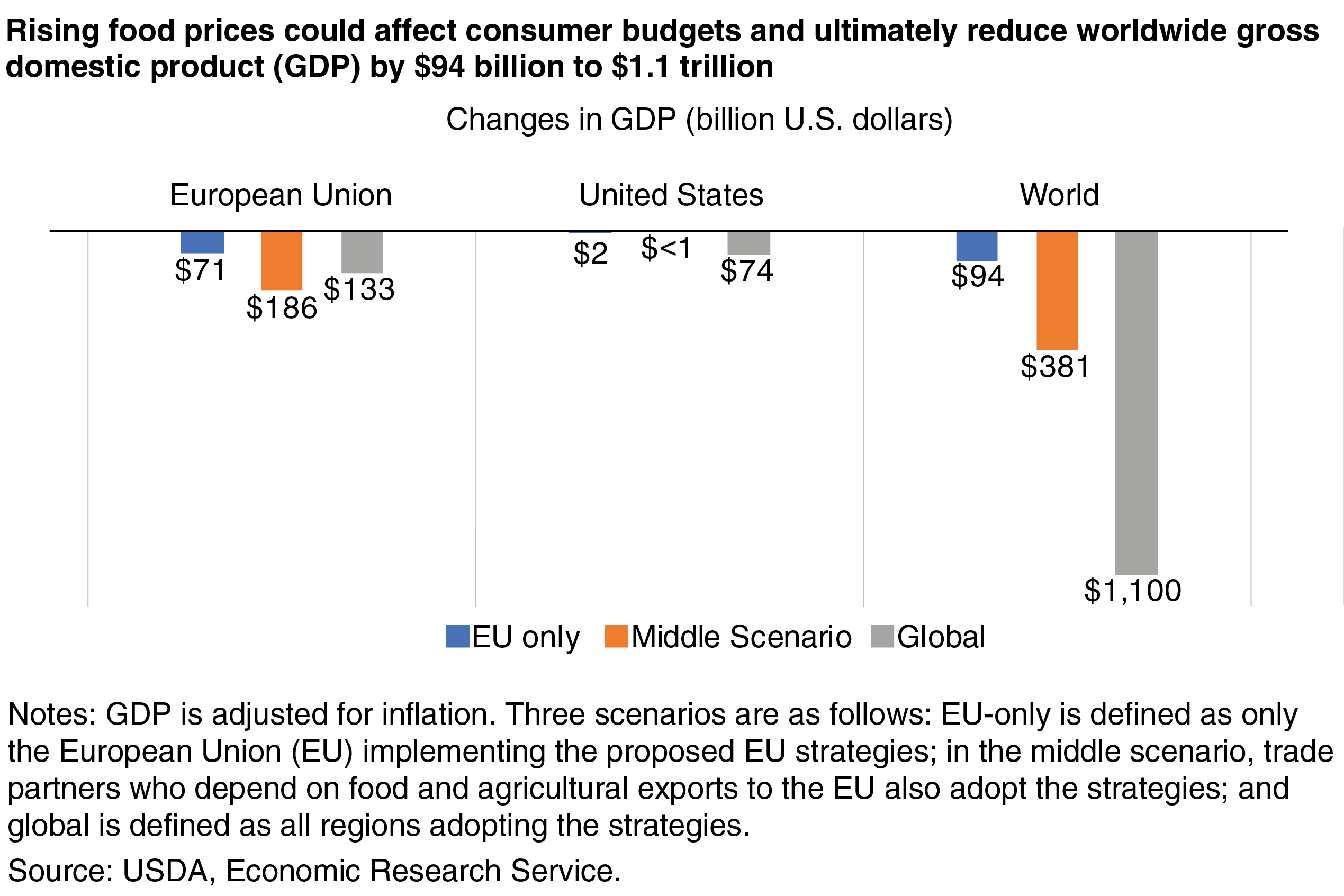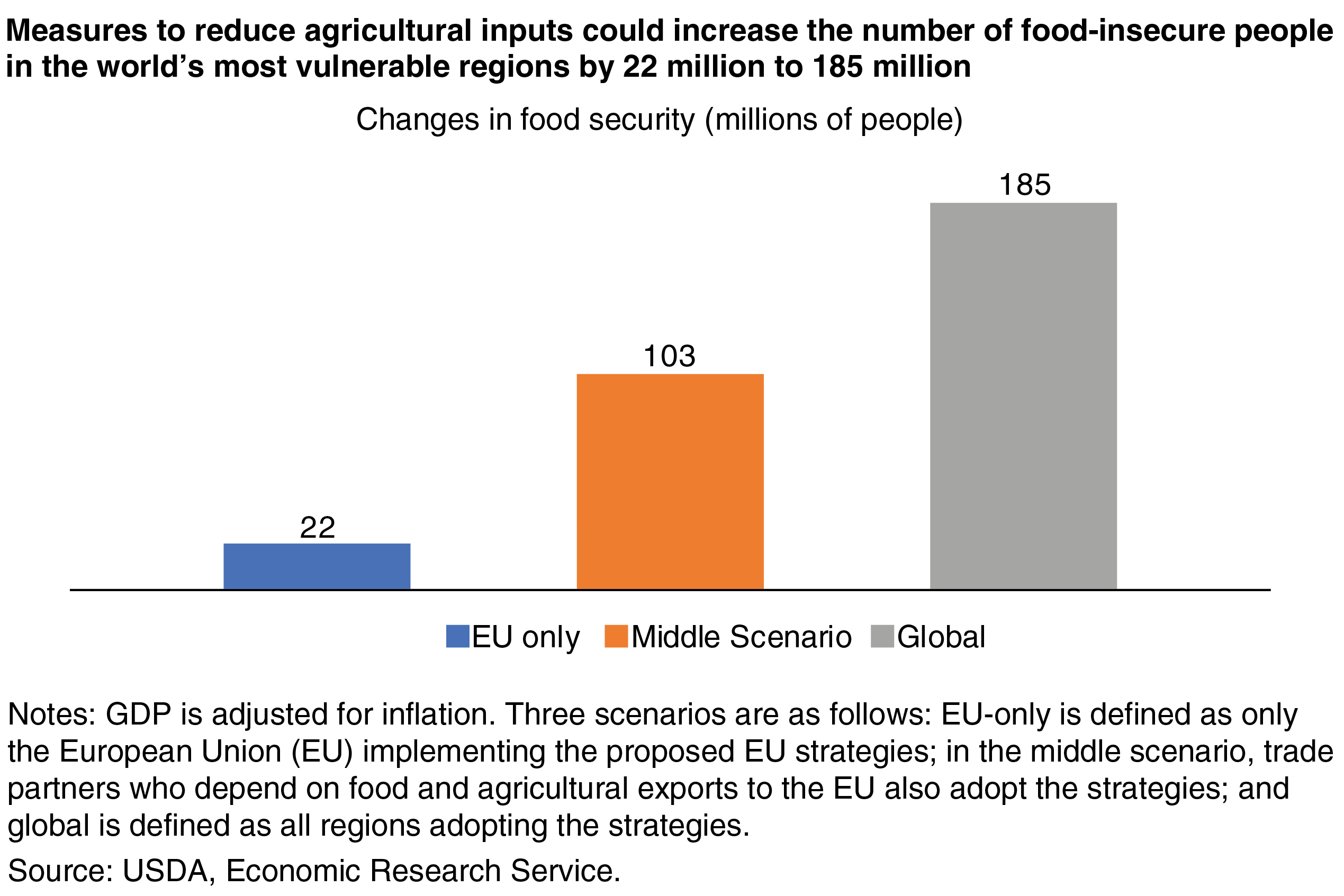
Farm to Fork Initiative to Restrict European Union Agricultural Inputs May Increase Food Prices, Further Global Food Insecurity
- by Jayson Beckman, Maros Ivanic, Jeremy Jelliffe, Felix G. Baquedano and Sara Scott
- 3/1/2021
Researchers at USDA’s Economic Research Service (ERS) recently evaluated the potential impacts of the Farm to Fork and Biodiversity Strategies proposed by the European Commission—the executive body of the European Union (EU). The initiative calls for restrictions in the use of certain agricultural inputs in EU agricultural production by 2030. The proposal pledges to use European Commission trade policies and other international efforts to promote a vision of sustainability in agriculture, which could have implications beyond countries in the EU. As part of a broader EU Green Deal, these policy initiatives would call for reductions in the use of fertilizer (20 percent), pesticide (50 percent), antimicrobials (50 percent), and the removal of existing farmland from agricultural use (10 percent) by 2030 relative to 2020 levels.
These targeted reductions in agricultural inputs could impact food prices in at least three ways. First, production costs could increase as farmers substitute labor for other inputs. Second, agricultural output could decrease as a result of fewer inputs being used. Third, prices on the international market could increase because of the tightening of available supplies and inelastic food demand. These rising costs could affect consumer budgets and ultimately reduce worldwide Gross Domestic Product (GDP), and, consequentially, increase the number of food-insecure people in the world’s most vulnerable regions.
To assess the potential effects of the proposed policies, ERS researchers investigated three scenarios. The “EU-only” scenario imposes the mandated reduction in EU countries only. In the “middle scenario,” trade partners who depend on food and agricultural exports to the EU also conform to the same input restrictions and impose import restrictions on food imports from those countries that do not conform. In the final “global scenario,” the measures are adopted on a global scale.
In cultivating crops and other primary agricultural products, farmers use land, labor, capital (such as tractors and other machinery), and other inputs such as seed, fertilizer, and pesticides. To offset reductions in inputs, other inputs such as labor could be used as substitutes. New and additional management practices, such as alternative methods for weed and pest control, could also fill in for the reduction in inputs, but these shifts in resources can both increase production costs and impact production.
Under the scenario with the EU alone adopting the measures, EU agricultural production would fall 12 percent, as indicated in the chart above. The reductions in the EU would translate to a worldwide decrease in output by 1 percent. In the United States, production of certain commodities could increase but would be almost entirely offset by reduced production in other commodities, with less than 0.5 percent total agriculture growth. The same effect would occur in the middle scenario, in which U.S. agricultural production would generally remain flat. In the scenario of global adoption of the EU’s input-reducing strategies, worldwide food and agricultural production volumes could fall as much as 11 percent. The United States could witness a decrease in food and agricultural output of 9 percent under this scenario.
A decline in agricultural production would result in a tightening of market availability of agricultural products, leading to price increases that ultimately affect consumer budgets. ERS modeling shows that an EU-imposed reduction in agricultural inputs would have the most immediate effect in the EU, where food prices are projected to climb 17 percent in this scenario (see chart above). With the EU prices increasing and affecting their trade with the rest of the world, a spillover effect would cause prices to also increase in other regions. U.S. food prices might increase by 5 percent while global food prices could increase by 9 percent. However, food cost increases would be significant for most regions under the scenario in which input restriction measures are adopted globally, with worldwide food prices growing by 89 percent. For the United States, under this global scenario, food prices could rise by 62 percent. Similarly, food prices in the EU could increase by 53 percent.
Because the EU is a major participant in international agricultural trade, these proposed policies could also lead to reduced global trade. A reduction in EU agricultural production and an increase in production costs could reduce its competitiveness in export markets across all three scenarios and increase the EU’s agricultural imports if the EU does not impose additional trade restrictions. If similar policies are pursued by countries outside the EU, then similar outcomes could occur—less agricultural production and higher prices. In the global scenario, worldwide agricultural trade could fall 4 percent.
Decreased agricultural output, reduced trade volumes, and projected increases in food commodity prices could impact GDP in the EU and on a global level. An EU-only imposed policy mandate would lower the EU’s GDP by $71 billion (see chart above), but because of secondary effects related to prices and trade, it would also decrease worldwide GDP by $94 billion. However, GDP decreases could be more significant if the input restrictions were adopted globally. GDP would fall by $133 billion in the EU and $1.1 trillion worldwide if the measures were implemented on a global scale. The impact to U.S. GDP would be relatively smaller than in the EU under all adoption scenarios.
Food insecurity, measured as the number of people who lack access to a diet of at least 2,100 calories a day, increases significantly in the 76 low- and middle-income countries studied in all scenarios. Increases in food commodity prices and declines in income would cause further food insecurity beyond current USDA projections, particularly in Africa. By 2030, the number of food-insecure people would increase by an additional 22 million in the case of EU-only adoption, as seen in the chart above. Under a global implementation of the input-reducing strategies, an additional 185 million people would be unable to access the average caloric level necessary to sustain a healthy and active lifestyle.
This article is drawn from:
- Beckman, J., Ivanic, M., Jelliffe, J., Baquedano, F.G. & Scott, S. (2020). Economic and Food Security Impacts of Agricultural Input Reduction Under the European Union Green Deal’s Farm to Fork and Biodiversity Strategies. U.S. Department of Agriculture, Economic Research Service. EB-30.
You may also like:
- Baquedano, F.G., Christensen, C., Ajewole, K. & Beckman, J. (2020). International Food Security Assessment, 2020–30. U.S. Department of Agriculture, Economic Research Service. GFA-31.





